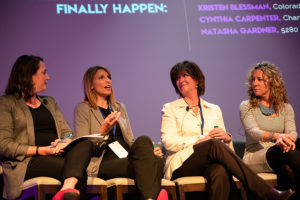Why the Road to Gender Equality Has So Many Steps


In the long struggle for gender equality in the workplace, it’s important to remember that many small things add up.
For example, when you compliment a woman on the job, what words do you use? Cynthia Carpenter, vice president of human resources and employee experience at Charter Communications, asks us to think about the implications of the accolades we give to women in a corporate setting.
“A male leader will be praising women,” said Carpenter, speaking about a typical boardroom meeting. “He’ll say ‘That woman over there, she has a positive attitude. She’s a ray of sunshine!’ But to men, he says: ‘That man drives results!’”
As an alternative, Stefanie Johnson, associate professor of management at the University of Colorado-Boulder’s Leeds School of Business, suggested how men could pivot to more equitable thinking in such situations: “Yes, we know she’s a ray of sunshine, but let’s focus on her skills.” Perceived gender roles have implications for advancement, Carpenter added: “How do you promote? Not for smiles!”
At a recent From Day One conference in Denver, a panel of five female leaders discussed real-world ways that everyone in business can help achieve gender equality in the workplace, moderated by Natasha Gardner, articles editor of Denver’s 5280 magazine. The focus was not so much on women getting jobs, and the infamous pay gap, but on the types of jobs women get and how they can advance within their workplace.
Among the things holding companies back from promoting women are unconscious bias and lack of mentorship. Men need to be allies, to speak up when given the opportunity, and to actively invite women to take on special projects, panelists said. A leader should make a list of who they normally go to for such tasks and then make an effort to rotate those opportunities fairly to women who deserve them–even if they haven’t been agitating for the assignments.
What is that? Women are socialized to speak up less. Yet studies show that we perceive women as speaking far more than they actually do during normal conversations. Likewise, when asked how many opportunities a woman is getting within an organization, men often overestimate the numbers.
This is why the panel agreed it’s important to have accurate statistics about who is advancing in your company–and when, and why. Pattie Money, chief people officer for SendGrid, said that her company has set a goal to have 50/50 gender parity by 2030.

“Men are fearful and it is preventing opportunities for women,” said Kristen Blessman, CEO of the Colorado Women’s Chamber of Commerce, recalling the time her male boss critiqued her attire, saying she “looked like a prostitute.” Blessman decided to deal with the issue herself. “Instead of going to HR, I told him directly.” When men and women can have a rapport and a connection based on respect instead of fear, she said, conflict resolution becomes a lot easier.
Aggravating the problem, however, is a backlash in the wake of the #MeToo movement, in which men perceive an adversarial environment. Many feel threatened by the perception that a woman is watching and waiting for them to screw up, cataloguing their every move.
The solution may lie in education. Specifically, cultural-competence education, and not just for men. Women need to work towards healthy dialogue, too. Most importantly, women need to stop shaming people for their opinions, which cuts off the opportunity for any conversation, said Blessman. “We are never going to change bias if we keep shaming people.”
By being honest and aware of the fact that some men feel pitted against women, companies can address the root causes of bias and work to change them. In an organizational structure, does change come from the top or the bottom? Yolanda Chase, director of Workplace Forward diversity and inclusion at Arrow Electronics, said she believes that change should start at the top. She advocates educating male executives on cultural competence with a “bias-busting toolkit,” which keeps the shaming to a minimum.
Looking to the future, the millennial generation is being heralded as the bringers of cultural change. Some companies have tried to leverage their influence by promoting reverse mentoring, in which the young help guide their elders.
Another way to change the conversation, panelists said, is to turn it from an “or” to an “and.” It's not women instead of men, it's women alongside men. Companies should also be transparent about their diversity data, which stops speculation and gossip.
Women need to be fearless in their approach to the issue, willing to have the conversation that is uncomfortable, the speakers said. They can cultivate a relationship with male colleagues that allows for an open and non-judgmental exchange of ideas.
Most importantly, instead of seeking out employees who "fit in," company leaders should encourage diversity of thought and healthy dialogue as a way to expand their company’s horizons–and increase the bottom line.
"If you have a job posting that contains the words ‘cultural fit,’ take that out," said Carpenter. "It’s one small thing at a time."
Kyria Abrahams is the author of I'm Perfect, You're Doomed (Simon & Schuster 2008). She is a writer and photojournalist whose work has been published in Narratively, among other publications. She lives in Denver with her husband and three cats
The From Day One Newsletter is a monthly roundup of articles, features, and editorials on innovative ways for companies to forge stronger relationships with their employees, customers, and communities.